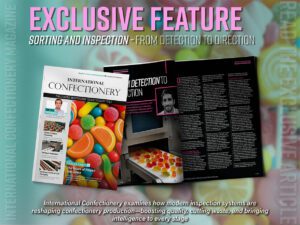Understanding the production process of sugars, sweeteners and the alternative options available to health-conscious consumers.
What makes confectionery stand out and what makes a product fall under the category of confectionery? Of course, what makes a product a confectionery item is the unique sweet flavours that the given product produces on an individual’s taste buds. Sweetness is what sets confectionery items apart which is why sugar and sweeteners are so important in the confectionery manufacturing process. Sugar is seen as quite an addictive substance that has a variety of positive and negative impacts; therefore, this feature wishes to assess the ways in which sugars and sweeteners are produced and the heathier alternatives available to attract health-conscious consumers.
Understanding sugar and sweeteners
As briefly touched upon, sugar is a generic name for a food product that is sweet tasting. It is a soluble carbohydrate and falls under two categories, simple sugars and compound sugars. Simple sugars include glucose, fructose and galactose. Compound sugars or double sugars are molecules made of two monosaccharides joined by a glycosidic bond.
Sweeteners on the other hand are slightly different. There are several types of sweeteners such as natural and artificial sweeteners. Natural sweeteners are sugar substitutes that are derived from natural products. Artificial sweeteners, however, are a synthetic sugar substitute that provides the taste of sugar while containing significantly less energy than sugar-based sweeteners making it zero-calories/low calories. Artificial sweeteners tend to be used in processed foods such as candy, soft drinks and puddings.
History of sugar and sweeteners
Sugar has a very fascinating history; it began its production in India where sugarcane plants were grown around the first century AD. The word “sugar” itself is believed to derive from the Sanskrit word called sharkara meaning sand or gravel. Originally people hewed sugarcane raw to access the sugary sweetness within. During the Gupta dynasty, the Indians discovered how to crystallise sugar around 350 AD. Indian sailors then transported this sugar via various trade routes and through this the practice moved to China and the Middle East where it slowly became a staple of cooking and desserts.
The methods of refining sugar during this period involved grinding or pounding the cane to extract the juice and then boiling and drying the juice in the sun to yield the sugar into a solid that looked like gravel. In 1792 sugar prices and popularity soared in Great Britain and the impact of colonisation not only caused sugar to spread across the globe but also made it a commercial and highly expensive item. Sugar in turn became a valuable commodity that was on par with pearls and musk. However, colonisation and the mass production of sugar could only occur in this period due to the vast amount of slave labour utilsed.
The 18th century saw the production of sugar become slowly mechanised where steam engines were used to power sugar mills. As the industrial revolution saw more sugar being produced at a higher rate and as social mobility began to become a much easier process, accessibility to sugar increased and its status declined. This has led to what modern society sees sugar as now, a readily available commonplace household item that is cheap and manufactured through a mechanical process.
Read more of this article in our latest edition here: March 2022 Single Issue form – International Confectionery Magazine (in-confectionery.com)
Media contact
Roshini Bains,
Editor, International Confectionery
Tel: +44 (0) 1622 823 922
Email: [email protected]








